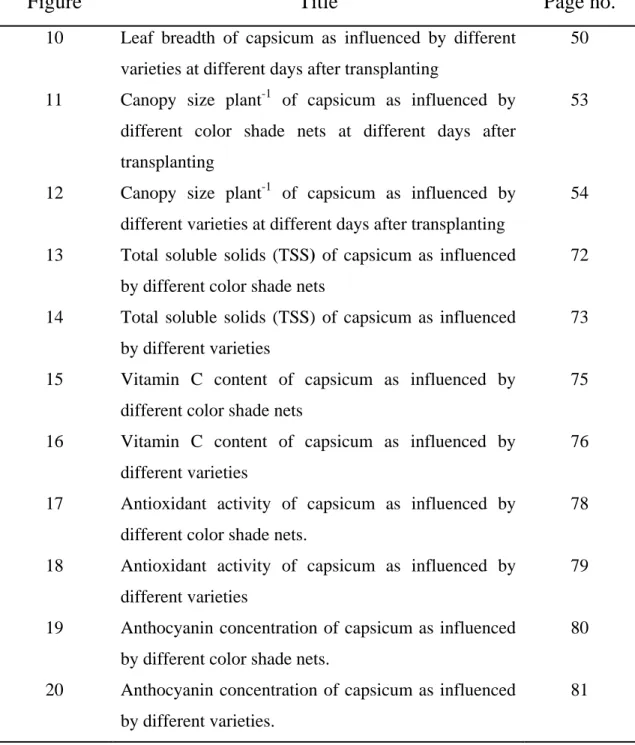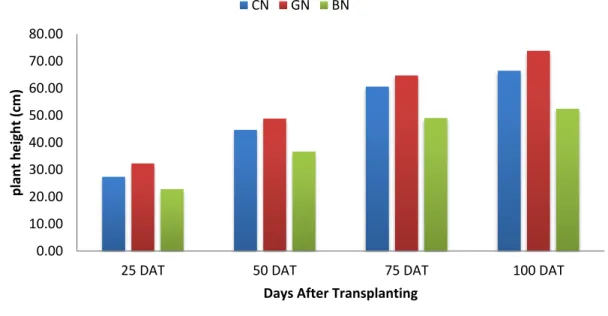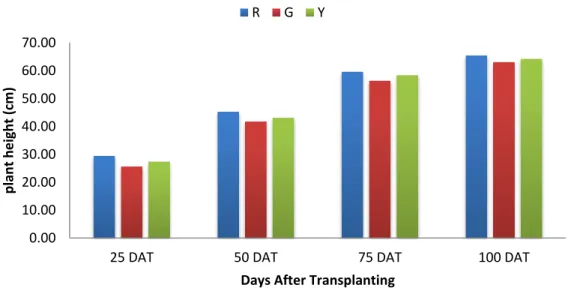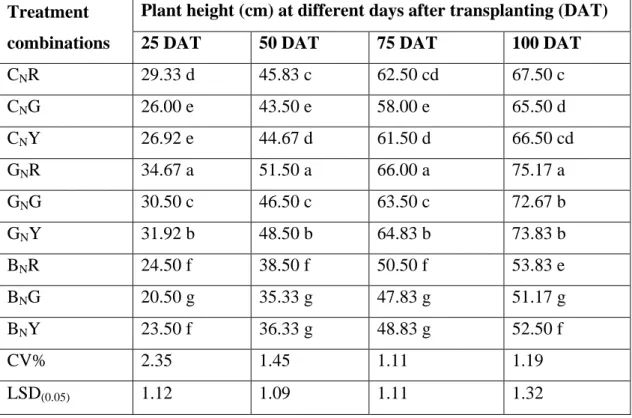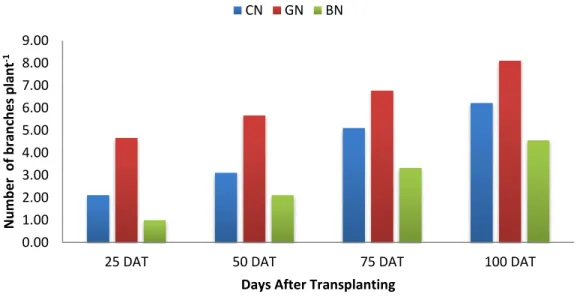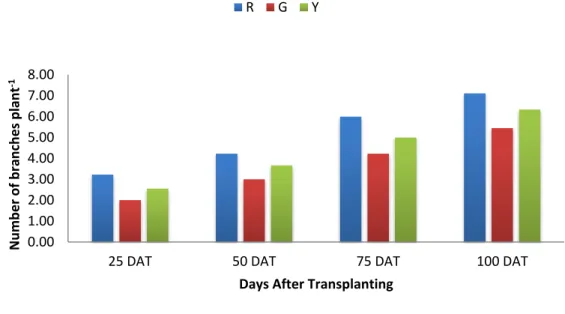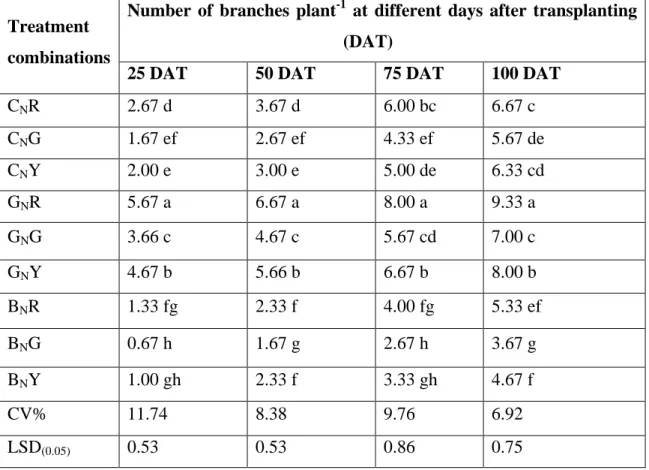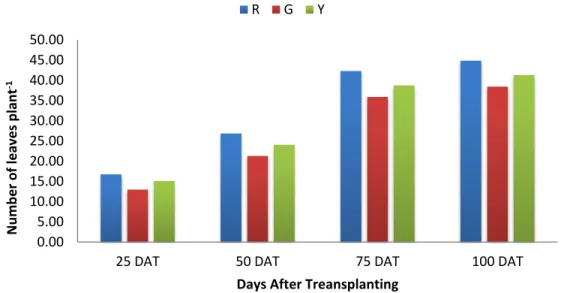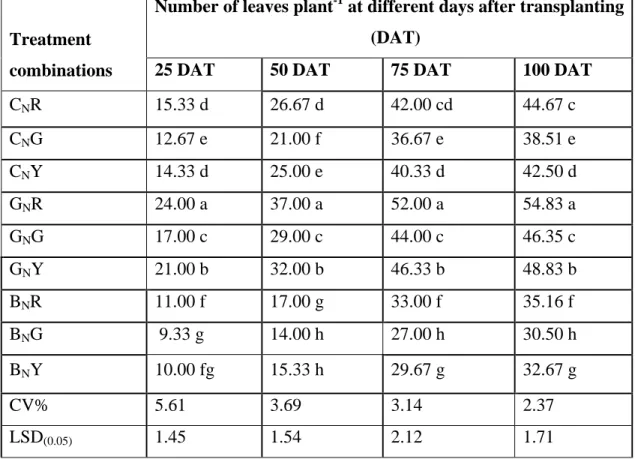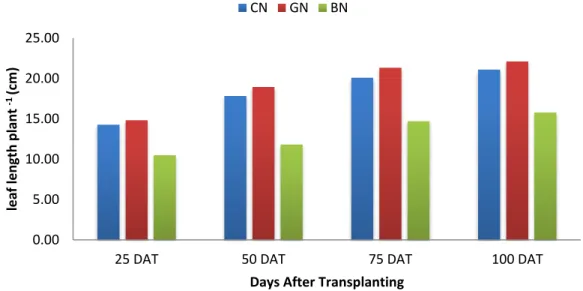EFFECTS OF COLOR SHADE NETS ON
GROWTH, YIELD AND QUALITY OF CAPSICUM
SUMMY AKTER SUMONA
.
DEPARTMENT OF HORTICULTURE
SHER-E-BANGLA AGRICULTURAL UNIVERSITY DHAKA-1207
JUNE, 2020
EFFECTS OF COLOR SHADE NETS ON
GROWTH, YIELD AND QUALITY OF CAPSICUM
BY
SUMMY AKTER SUMONA
Reg. No. 18-09092A Thesis
Submitted to the Department of Horticulture Sher-e-Bangla Agricultural University, Dhaka-1207
In partial fulfillment of the requirements for the degree
of
MASTER OF SCIENCE (MS) IN
HORTICULTURE
SEMESTER: JANUARY-JUNE, 2020 Approved by:
________________________________
Prof. Dr. Md. Jahedur Rahman Chairman
Examination Committee ________________________________
Prof. Dr. Md. Nazrul Islam Department of Horticulture Sher-e-Bangla Agricultural University
Dhaka - 1207 Supervisor
_______________________________
Prof. Dr. A. H. M. Solaiman Department of Horticulture Sher-e-Bangla Agricultural University
Dhaka - 1207 Co-Supervisor
Alhamdulillah
All praise to Almighty Allah
“my creator, my strong pillar and my source of inspiration’’
Dedicated to-
My Beloved parents “My love for you people shall live forever’’
DEPARTMENT OF HORTICULTURE Sher-e-Bangla Agricultural University
Sher-e-Bangla Nagar, Dhaka-1207 Ref... Date: ...
CERTIFICATE
This is to certify that the thesis entitled “Effects of color shade nets on growth, yield and quality of capsicum” submitted to the Department of Horticulture, Faculty of Agriculture, Sher-e-Bangla Agricultural University, Dhaka, in partial fulfillment of the requirements for the degree of MASTER OF SCIENCE in HORTICULTURE, embodies the result of a piece of bona fide research work carried out by Summy Akter Sumona, Registration No. 18-09092, under my supervision and guidance. No part of this thesis has been submitted for any other degree or diploma.
I further certify that such help or sources of information as has been availed of during the course of this investigation have been duly acknowledged.
_________________________
Dated: June, 2020 Prof. Dr. Md. Nazrul Islam Place: Dhaka, Bangladesh Department of Horticulture
Sher-e-Bangla Agricultural University Dhaka -1207
Supervisor
i
ACKNOWLEDGEMENTS
All praises goes to the Almighty Allah, the Supreme Ruler of the universe, who enabled the author for successful completion of this research work.
The author would like to expresses her heartiest gratitude and thanks to his research Supervisor, Prof. Dr. Md. Nazrul Islam, Department of Horticulture, Sher-e-Bangla Agricultural University, Dhaka 1207, for his scholastic guidance and constant encouragement during the entire period of the research work and in the preparation of the manuscript of the thesis. The author also cordially expresses her thankfulness and best esteems to respected Co-Supervisor Prof. Dr. A. H. M. Solaiman, Department of Horticulture, Sher-e-Bangla Agricultural University, Dhaka 1207, for his encouragement, prized advice, valuable suggestion, constructive criticisms, special help and co-operation during the occupancy of this research work, as well as preparing of this thesis and providing all the necessary facilities during entire period of this study.
The author expresses her gratitude and indebtedness to all the honorable course teachers of the Dept. of Horticulture, Sher-e-Bangla Agricultural University, for their sympathetic help and co-operation in various stages towards completion of this research work.
Finally, the author is deeply grateful to her beloved parents, brothers, friends and other well-wishers specially S. M. Anamul Arefin, Suchona, Sharika Hydar, Rasel and Osman Goni for their constant inspiration and moral support which can never be forgotten.
The Author
ii
EFFECTS OF COLOR SHADE NETS ON GROWTH, YIELD AND QUALITY OF CAPSICUM
BY
SUMMY AKTER SUMONA ABSTRACT
An experiment was conducted in the Horticulture farm of Sher-e-Bangla Agricultural University, Dhaka, during the period from October 2019 to April 2020, to find out the effects of color shade nets on growth, yield and quality of capsicum. The experiment consisted with two factors. Factor A: Three types of color shade nets such as CN - White color shade net (control), GN - Green color shade net (25%) and BN - Black color shade net (40%). Factor B: Three varieties such as R - F1 Hybrid Sweet Pepper (Lalima), G - Peperone Yolo Wonder and Y - BARI Mistimorich 2. The experiment was laid out in Randomized Complete Block Design (RCBD) with three replications. Results revealed that in terms of yield and yield contributing parameters, GNR gave the highest yield plant-
1 (318 g) and fruit yield (34.52 t/ha) where the lowest yield plant-1 (121 g) and fruit yield (13.13 t/ha) was recorded from the treatment BNG. In terms of quality parameters, the highest (10.23%) total soluble solids (TSS) was obtained from CNR and the lowest (3.80
%) total soluble solids (TSS) was obtained from BNG. The highest vitamin C content (164.50 mg. 100g-1) was obtained from CNG where the lowest (146.63 mg.100g-1) was obtained from BNY. The highest antioxidant activity (81.16%) and anthocyanin concentration (10.47 mg/100gFw) was obtained GNR whereas the lowest antioxidant activity (71.75 %) and anthocyanin concentration (4.23 mg/100gFw) was obtained from BNG. From economic point of view the highest BCR (4.25) was obtained from GNR and lowest BCR (1.04) was obtained from BNG. Green shade net (GN) with F1 Hybrid Sweet Pepper (R) gave the best performance among all the treatment combinations.
iii
LIST OF CONTENTS
Chapter Title Page no.
ACKNOWLEDGEMENTS i
ABSTRACT ii
LIST OF CONTENTS iii-x
LIST OF TABLES xi-xii
LIST OF FIGURE xiii-xiv
LIST OF PLATES xv
LIST OF APPENDICES xvi-xvii
LIST OF ABBRIVIATIONS xviii
I INTRODUCTION 1-2
II REVIEW OF LITERATURE 3-10
III MATERIALS AND METHODS 11-28
3.1 Description of experimental site 11
3.1.1 Experimental site 11
3.1.2 Characteristics of soil 11
3.1.3 Climate condition of the experimental site 12
3.2 Details of experiment 12
3.2.1 Planting materials 12
3.2.2 Earthen pot preparation for seed germination 12
3.2.3 Seed sowing 12
3.2.4 Raising of seedlings 12
3.2.5 Treatments 13
3.2.6 Design and layout of the experiment 13
3.2.7 Preparation of shade house 15
3.2.8 Grow bag preparation 17
3.2.9 Fertilizer application 17
3.3 Growing of the crops 17
iv
LIST OF CONTENTS (CONT’D)
Chapter Title Page no.
3.3.1 Transplanting of seedlings 17
3.3.2 Intercultural operations 17
3.3.3 Irrigation 17
3.3.4 Gap filling 18
3.3.5 Weeding 18
3.3.6 Pruning 18
3.3.7 Staking 18
3.3.8 Control of pest and disease 18-19
3.3.9 Harvesting 19
3.4 Data collection 22-23
3.4.1 Measurement of environmental condition 23
3.4.2 Plant height (cm) 23
3.4.3 Number of branches plant-1 23
3.4.4 Number of leaves plant-1 24
3.4.5 Leaf length plant-1 (cm) 24
3.4.6 Leaf breadth plant-1 (cm) 24
3.4.7 Canopy size plant-1 (cm) 24
3.4.8 Days to 1st flowering 24
3.4.9 Days to 50% flowering 24
3.4.10 Number of flowers plant-1 24
3.4.11 Number of fruits plant-1 25
3.4.12 Fruit length (cm) 25
3.4.13 Fruit diameter (cm) 25
3.4.14 Fruit weight (g) 25
3.4.15 Yield plant-1 (g) 25
3.4.16 Yield (t/ha) 25
v
LIST OF CONTENTS (CONT’D)
Chapter Title Page no.
3.4.17 Color measurement 25-26
3.4.18 Total soluble solids (TSS) 26
3.4.19 Vitamin C content (mg. 100 g-1 FW) 26
3.4.20 Antioxidant activity (%) 26-27
3.4.21 Determination of anthocyanin (mg·100 g-1 FW)
27
3.4.22 Economic analysis 27-28
3.4.23 Statistical analysis 28
IV RESULTS AND DISCUSSION 29-85
4.1 Environmental condition 29-32
4.2 Plant height 33-35
4.2.1 Effect of color shade net on plant height 33 4.2.2 Effect of varieties on plant height 34 4.2.3 Combined effect of shade nets and varieties on
plant height
35
4.3 Number of branches plant-1 37-39
4.3.1 Effect of shade net on number of branches plant-1
37 4.3.2 Effect of varieties on number of branches
plant-1
38 4.3.3 Combined effect of shade nets and varieties on
number of branches plant-1
39
4.4 Number of leaves plant-1 41-43
4.4.1 Effect of color shade net on number of leaves plant1
41 4.4.2 Effect of varieties on number of leaves plant1 42
vi
LIST OF CONTENTS (CONT’D)
Chapter Title Page no.
4.4.3 Combined effect of shade nets and varieties on number of leaves plant-1
43
4.5 Leaf length 45-47
4.5.1 Effect of color shade net on leaf length 45 4.5.2 Effect of varieties on leaf length 46 4.5.3 Combined effect of shade nets and varieties on
leaf length
47
4.6 Leaf breadth 49-51
4.6.1 Effect of color shade net on leaf breadth 49 4.6.2 Effect of varieties on leaf breadth 50 4.6.3 Combined effect of shade nets and varieties on
leaf breadth
51
4.7 Canopy size plant-1 53-55
4.7.1 Effect of color shade net on canopy size plant1 53 4.7.2 Effect of varieties on canopy size plant-1 54 4.7.3 Combined effect of shade nets and varieties on
canopy size plant-1
55
4.8 Days to 1st flowering 57
4.8.1 Effect of color shade net on days to 1st flowering
57 4.8.2 Effect of varieties on days to 1st flowering 57
vii
LIST OF CONTENTS (CONT’D)
Chapter Title Page no.
4.8.3 Combined effect of shade nets and varieties on days to 1st flowering
57
4.9 Days to 50%flowering 57-58
4.9.1 Effect of color shade net on days to 50%
flowering
57 4.9.2 Effect of varieties on days to 50%flowering 58 4.9.3 Combined effect of shade nets and varieties on
days to 50%flowering
58 4.10 Number of flowers plant-1 58-59 4.10.1 Effect of different color shade net on number of
flowers plant-1
58 4.10.2 Effect of varieties on number of flowers plant1 58
4.10.3 Combined effect of shade nets and varieties on number of flowers plant-1
59
4.11 Number of fruits plant-1 62
4.11.1 Effect of color shade net on number of fruits plant-1
62 4.11.2 Effect of varieties on number of fruits plant-1 62 4.11.3 Combined effect of shade nets and varieties on
number of fruits plant-1
62
4.12 Fruit length 63
4.12.1 Effect of color shade nets on fruit length 63 4.12.2 Effect of varieties on fruit length 63 4.12.3 Combined effect of shade nets and varieties on
fruit length
63
4.13 Fruit diameter 63-64
viii
LIST OF CONTENTS (CONT’D)
Chapter Title Page no.
4.13.1 Effect of color shade nets on fruit diameter 63 4.13.2 Effect of varieties on fruit diameter 64 4.13.3 Combined effect of shade nets and varieties on
fruit diameter
64
4.14 Fruit weight (g) 64-65
4.14.1 Effect of color shade nets on fruit weight (g) 64 4.14.2 Effect of varieties on fruit weight (g) 64 4.14.3 Combined effect of shade nets and varieties on
fruit weight (g)
65
4.15 Yield plant-1 65
4.15.1 Effect of color shade nets on yield plant-1 65 4.15.2 Effect of varieties on yield plant-1 65 4.15.3 Combined effect of shade nets and varieties on
yield plant-1
66
4.16 Yield (t/ha) 66-67
4.16.1 Effect of color shade nets on yield (t/ha) 66 4.16.2 Effect of varieties on yield (t/ha) 66 4.16.3 Combined effect of shade nets and varieties on
yield (t/ha)
67
4.17 Color measurement 70
4.17.1 Combined effect of shade nets and varieties on color measurement
70
4.18 Total soluble solids (TSS) 72-74
ix
LIST OF CONTENTS (CONT’D)
Chapter Title Page no.
4.18.1 Effect of color shade nets on total soluble solids (TSS)
72 4.18.2 Effect of varieties on total soluble solids (TSS) 73 4.18.3 Combined effect of shade nets and varieties on
total soluble solids (TSS)
74
4.19 Vitamin C content 74-77
4.19.1 Effect of color shade nets on vitamin C content 74 4.19.2 Effect of varieties on vitamin C content 76 4.19.3 Combined effect of shade nets and varieties on
vitamin C content
77
4.20 Antioxidant activity 78-80
4.20.1 Effect of color shade nets on antioxidant activity 78 4.20.2 Effect of varieties on antioxidant activity 79 4.20.3 Combined effect of shade nets and varieties on
antioxidant activity
80
4.21 Anthocyanin determination 80-82
4.21.1 Effect of color shade nets on anthocyanin determination
80
4.21.2 Effect of varieties on anthocyanin determination 81 4.21.3 Combined effect of shade nets and varieties on
anthocyanin determination
82
4.22 Economic analysis 84
x
LIST OF CONTENTS (CONT’D)
Chapter Title Page no.
4.22.1 Gross return (Tk/ha) 84
4.22.2 Net return (Tk/ha) 84
4.22.3 Benefit cost ratio (BCR) 84
V SUMMARY AND CONCLUSION 86-89
REFERENCES 90-94
APPENDICES
95-106
xi
LIST OF TABLES
Chapter Title Page no.
1 Mean values of recorded (at 12:00 pm) temperature (0C) and RH (%) during the period of experiment
31 2 Mean values of recorded (at 12:00 pm) UV-reading
(mW.cm-2), solar radiation(W.m-2), Soil temperature (0C) and Soil moisture (%) during the period of experiment
32
3 Effect of different color shade nets in combination with varieties on plant height of capsicum
36 4 Effect of different color shade nets in combination with
varieties on number of branches plant-1 of capsicum
40 5 Effect of different color shade nets in combination with
varieties on number of leaves plant-1 capsicum
44 6 Effect of different color shade nets in combination with
fruit varieties on leaf length of capsicum
48 7 Effect of different color shade nets in combination with
varieties on leaf breadth of capsicum
52 8 Effect of different color shade nets in combination with
varieties on canopy size plant-1 of capsicum
56 9 Effect of different color shade nets on days to 1st
flowering, 50% flowering and number of flowers plant-1
60 10 Effect of varieties on days to 1st flowering, 50%
flowering and number of flowers plant-1
60 11 Combined effect of different color shade nets and
varieties on days to 1st flowering, 50% flowering and number of flowers plant-1
61
xii
LIST OF TABLES (CONT’D)
Chapter Title Page no.
12 Effect of different color shade nets on numbers of fruits plant-1, fruit length, fruit diameter, fruit weight (g), yield plant-1(g) and yield (t/ha) of capsicum
68
13 Effect of varieties on numbers of fruits plant-1, fruit length, fruit diameter, fruit weight (g), yield plant-1 (g) and yield (t/ha) of capsicum
68
14 Combined effect of different color shade nets and varieties on number of fruits plant-1, fruit length, fruit diameter, fruit weight (g), yield plant-1 (g) and yield (t/ha) of capsicum
69
15 Combined effect of different color shade nets and varieties on chromatic characteristics of the capsicum
71 16 Combined effect of different color shade nets and
varieties on TSS, Vitamin C and antioxidant activity and anthocyanin concentration of capsicum
83
17 Cost and return of capsicum cultivation as influenced by different color shade nets and varieties
85
xiii
LIST OF FIGURE
Figure Title Page no.
1 Plant height of capsicum as influenced by different color shade nets at different days after transplanting
33 2 Plant height of capsicum as influenced by different color
varieties at different days after transplanting
34 3 Number of branches plant-1 of capsicum as influenced
by different color shade nets at different days after transplanting
37
4 Number of branches plant-1 of capsicum as influenced by different color varieties at different days after transplanting
38
5 Number of leaves plant-1 of capsicum as influenced by different color shade nets at different days after transplanting
41
6 Number of leaves plant-1 of capsicum as influenced by different color varieties at different days after transplanting
42
7 Leaf length of capsicum as influenced by different color shade nets at different days after transplanting
45
8 Leaf length of capsicum as influenced by different varieties at different days after transplanting
46 9 Leaf breadth of capsicum as influenced by different
color shade nets at different days after transplanting
49
xiv
LIST OF FIGURE (CONT’D)
Figure Title Page no.
10 Leaf breadth of capsicum as influenced by different varieties at different days after transplanting
50 11 Canopy size plant-1 of capsicum as influenced by
different color shade nets at different days after transplanting
53
12 Canopy size plant-1 of capsicum as influenced by different varieties at different days after transplanting
54 13 Total soluble solids (TSS) of capsicum as influenced
by different color shade nets
72 14 Total soluble solids (TSS) of capsicum as influenced
by different varieties
73 15 Vitamin C content of capsicum as influenced by
different color shade nets
75 16 Vitamin C content of capsicum as influenced by
different varieties
76 17 Antioxidant activity of capsicum as influenced by
different color shade nets.
78 18 Antioxidant activity of capsicum as influenced by
different varieties
79 19 Anthocyanin concentration of capsicum as influenced
by different color shade nets.
80 20 Anthocyanin concentration of capsicum as influenced
by different varieties.
81
xv
LIST OF PLATE
Plate no. Title Page no.
1 Layout of the experiment 14
2 Different color shade nets 16
3 Photograph showing 3(a) Raising of seedlings; 3(b) Polybagging of seedling; 3(c) Prepared grow bags; 3(d) Transplanting of seedlings; 3(e) Used Yellow sticky traps; 3(f) Used pheromone traps
20
4 Photograph showing 4(a) Fruit weight determined using digital weight machine; 4(b) Color measurement; 4(c) Sample preparation for TSS measurement; 4(d) Filter with whatman filter paper; 4(e) Sample centrifuged for anthocyanin determination ; 4(f) Sample prepared for antioxidant determination; 4(g) Spectrophotometer used for antioxidant reading; 4(h) Refractometer used for TSS measurement
21
xvi
LIST OF APPENDICES
Chapter Title Page no.
I Characteristics of Sher-e-Bangla Agricultural University soil is analysed by Soil Resources Development Institute (SRDI), Khamar Bari, Farmgate, Dhaka
95
A Morphological characteristics of the experimental field
95 B Physical and chemical properties of initial soil 95 II Monthly records of air temperature, relative humidity
and rainfall during the period from October 2019 to February 2020
96
III Analysis of variance of the data on temperature (0C) and relative humidity (%)
97 IV Analysis of variance of the data on UV-radiation
(mW.cm-2) and solar radiation (W.m-2)
98 V Analysis of variance of the data on soil temperature
(0C) and soil moisture (%)
99 VI Analysis of variance of the data on plant height and
number of branches plant-1 at different DAT of capsicum as influenced by different color shade nets and fruit varieties
100
VII Analysis of variance of the data on number of leaves plant-1 and canopy size plant-1 at different DAT of capsicum as influenced by different color shade nets and varieties
101
xvii
LIST OF APPENDICES (CONT’D)
Chapter Title Page no.
VIII Analysis of variance of the data on leaf length and leaf breadth at different DAT of capsicum as influenced by different color shade nets and varieties
102
IX Analysis of variance of the data on days to 1st flowering, days to 50%flowering, flower/ plant, fruit plant-1, fruit length, fruit diameter, individual fruit weight (g), yield plant-1 (g) and yield (t/ha) of capsicum as influenced by different color shade nets and varieties
103
X Analysis of variance of the data on days to color measurement total soluble solids, vitamin C, antioxidant activity and anthocyanin determination of capsicum as influenced by different color shade nets and varieties
104
XI Per hectare production cost of capsicum 105-106
xviii
LIST OF ABBRIVIATIONS
Abbreviations Elaborations
% Percentage
0C Degree Celsius
Agril. Agricultural
ANOVA Analysis of variance
B Boron
BARI Bangladesh Agricultural Research Institute
cm Centimeter
CV% Percentage of Coefficient of Variation
df Degrees of Freedom
et al. and others (at elli)
g Gram
K Potassium
kg Kilogram
LSD Least Significant Difference
MP Muriate of Potash
NS Non-significant
ppm Parts per Million
RCBD Randomized Complete Block Design
RH Relative Humidity
SAU Sher-e-Bangla Agricultural University SRDI Soil Resources Development Institute
t/ha Tonne Per Hectare
TSP Triple Super Phosphate
1
CHAPTER I INTRODUCTION
Sweet pepper (Capsicum annuum, Solanaceae) is one of the most important vegetable crops grown extensively throughout the world especially in the temperate countries. The genus Bell pepper contains about 20 species and now five domesticated species Capsicum annuum, C. frutescens, C. chinense, C. baccatum, C. pubescens are only recognized. All these species of sweet pepper have many cultivated varieties suited to different agro-climatic conditions.
In Bangladesh it is commonly known as capsicum. Sweet pepper is considered a minor vegetable crop in Bangladesh (Hasanuzzaman, 1999). The popularity of sweet pepper is increasing day by day in Bangladesh especially among the urban people because of its high nutritive value and possible diversified use in making different palatable foods. It is chosen because of its higher nutritive value and generally it contains 1.29 mg protein, 11 mg calcium, 870 I.U. vitamin A, 17.5 mg ascorbic acid, 0.6 mg thiamin, 0.03 mg riboflavin and 0.55 mg niacin per 100 g of edible fruit (Joshi and Singh, 1975). It has different colors-range from green to yellow, red, orange, purple, and black. Other sweet peppers include the red, heart-shaped; the pale green, slender and curved bull’s horn which range in color from yellow to red and sweet banana pepper which is yellow and banana shaped (Teshm Tadesse Michael et al., 1999).
Capsicum is the most important summer crop of temperate regions but now a days effort are being made to grow sweet pepper in Bangladesh (Paul, 2009). Some advanced farmers grow capsicum sporadically to meet the demand of the periphery of Dhaka city (Saha and Salam, 2004). The optimum temperature requirement for sweet pepper growth ranged from 16-250 C. High night temperature is more detrimental to fruit set than day temperature (Rylski and Spigelman, 1982). Sweet pepper is very sensitive to environmental factors (Bhatt et al., 1992). Owing to its sensitivity, its yield is affected significantly. Sweet pepper production has some constraints which include flower
2
dropping, poor fruit set, and susceptibility to viral diseases and it is a serious concern for the successful introduction of this crop. However, photo-selective shade nets may be effective to reduce dropping of sweet pepper and may increase fruit number, fruit size and fruit weight.
The application of photo-selective netting technology is gaining popularity around the world. This practice is already popular in Europe, especially in Israel (Fallik et al., 2009;
Kong et al., 2013) and other Mediterranean countries (Diaz-Perez, 2014) as well as in South Africa (Mashabela et al., 2015; Selahle et al., 2015). Photo-selective shade-nets provide physical protection against hail, wind, bird and insect-transmitted virus diseases (Shahak, 2008). Reducing the transmitted solar radiation under shading reduces the canopy and air temperatures as well as the transpiration rate in the greenhouses. This consequently reduces the water consumption by about 50%, increases the water use efficiency and enhances the crop productivity up to 40% (Ahemd. et al., 2016).
Regardless of the stress level, light quality changes could potentially alter the crop’s physiological and biochemical processes, metabolite profiles and ultimately growth, development, yield and quality. Light quality and different wave lengths were reported to affect fruit colour and maturation (Alkalai-Tuvia et al., 2014). Ripening inhibition can be associated with less fruit susceptibility to fungal infection in the field (Goren et al., 2011), produce better crop yields (Ilic et al., 2011) and lower the fruit susceptibility to decay during post-harvest storage (Shahak, 2014; Selahle et al., 2015).
Considering the above mentioned facts, the present investigation was undertaken with the following objectives-
i. To evaluate the effects of different color shade nets on plant growth and yield of capsicum.
ii. To investigate the effects of different color shade nets on quality of capsicum.
3
CHAPTER II
REVIEW OF LITERATURE
The photo selective, light dispersive shade nets provide a new, multi benefit tool for crop protection. Changing the light intensity and radiation spectrum has a large impact on the total production system. Research on light in horticultural systems is necessary for a sustainable and market-oriented greenhouse production in the future. This technology has the ability to extend the shelf life of produce, thereby lowering postharvest losses.
Overall, photo-selective netting has proven to be a cost effective approach for manipulating crop microclimate properties in order to regulate not only yield, but also the retail eating quality as well as functional or bioactive properties of vegetables that are associated with human health and wellbeing.
Some of the research findings relevant to the growth and yield of capsicum as influenced by different color shade nets and verities have been reviewed here.
Ilic et al. (2017) conducted an experiment with sweet pepper (Capsicum annuum L.) under four different coloured shade-nets (pearl, red, blue and black) with 40% relative shading. The aim of the study was to determine how different environmental control technologies, coloured shade-nets as net house or plastic-house integrated with coloured shade-nets, could influence plant parameters, production and quality traits in pepper fruits. The highest concentration of total soluble solids (TSS) was detected in pepper fruits grown under the open field conditions (8.03%). Pepper fruits grown in plastic tunnels had significantly lower TSS content (6.58%). The highest concentration of vitamin C was detected in peppers grown in plastic tunnels integrated with red coloured nets (175.77 mg 100 g-1). These results show that red and pearl photoselective nets create optimal growing conditions and increase the total fruit yield as well as the number of fruits with fewer physiological disorders and with thicker pericarp.
4
Ledone et al. (2017) conducted an experiment Sweet pepper (Capsicum annuum L.) cultivated under plastic tunnel by unheated technology. Sweet pepper plants can suffer from high temperature and radiation during the summer season. However, photoselective- shading nets can provide a new tool for radiation quality manipulation and support the plant development and fruit quality. The effect of shading of coloured nets depends on solar radiation conditions and on other environmental factors. A sweet pepper variety was grown in South-East Hungary under plastic tunnels using different coloured nets, such as white, yellow, green and red nets during summer 2013. Results of the trial have proved that green coloured net usually decreased the yield, while yellow and red nets can increase the yield and the fruit quality. Growers have to consider the shading intensity of the net, which should not be higher than 35-40%.
Ambrozy et al. (2016) examined in ’Karpex’ red colored sweet pepper hybrid (Capsicum annuum L.) using photo-selective shading nets were CN red from Israel, and yellow, red, green, and white from Hungary, all with 40% shade factor. We found a significantly higher yield under the yellow and red net compared with the unshaded control. The yield was more than 50% higher under the yellow net (33.6 t ha-1), than in the control plot (15.5 t ha-1; F5, 12=10.761, p<0.001). All shading nets had a significantly positive effect against sunburn at the first harvest (F5, 12=12.403, p<0.001), except for the white shading net. In addition, no sunscald fruit were observed under CN red net and green net, compared to 4 t.ha-1 losses due to sunburn in the control plot. No sunscald pepper fruit were detected at the second harvest. In contrast, the ratio of red and yellow pigments was higher at the first harvest. Hence, the earlier harvest is recommended in order to produce pepper fruits with attractive red color. Significantly higher yield was found under yellow and red net compared with the control. The lowest yield was found in the control (15.5 t ha-1), it was more than 50% lower than under yellow net (33.6 t ha-1). In conclusion, the use of net shading technology resulted in increased yield, reduced sunscald, and can be tailored to improve fruit color.
Selahle et al. (2015) investigated in this study Postharvest responses of red (‘HTSP-3’) and yellow (‘Celaya’) sweet pepper fruit yield, quality parameters and bioactive compounds (to three types of photo-selective nets and a standard black net). Red and
5
yellow peppers produced under the black net retained higher b-carotene(9.39 µg g FW-1) than yellow (6.64 µg g FW-1) ,pearl (5.28 µg g FW-1), red (6.60 µg g FW-1) and lower total phenolic contents (7.57 mg GAE 100 g FW-1)) compared to yellow (9.79 mg GAE 100 g FW-1), pearl (11.12 mg GAE 100 g FW-1), red (10.06 mg GAE 100 g FW-1) and showed deep red and orange colour after storage. Both peppers produced under the pearl net retained a higher ascorbic content (22.88 mg 100 g FW-1 ) than yellow (18.69 mg 100 g FW1) , black (17.08 mg 100 g FW-1) , red (20.27 mg 100 g FW-1) and antioxidant scavenging activity (.389 mg GAE g-1 FW) than yellow (.165 mg GAE g-1 FW), black (.144 mg GAE g-1 FW) , red (.162 mg GAE g-1 FW) and also reduced weight loss after storage. Red and yellow peppers grown under pearl and yellow nets resulted in a higher percentage of marketable fruit, after storage. Red pepper grown under the yellow net showed a higher number of odour active aroma compounds in the fruit, while black nets significantly affected the synthesis of odour active aroma compounds during storage.
Sensory analysis indicated a preference for red pepper fruits after storage from plants grown under pearl nets.
An experiment was executed by Mashabela et al. (2015) in this study, influence of 3 types of photo-selective nets (pearl, red and yellow) and a standard black net on marketable yield, fruit quality and bioactive compounds after postharvest storage was investigated. Percentage marketable fruits were higher in green sweet peppers produced under the pearl nets. Fruits produced under the pearl nets showed higher fruit mass (195.8 g), firmness (5.87 kg), chlorophyll content (290 µg/g FW) , ascorbic acid content (24.67 mg/100g FW ), antioxidant scavenging activity (1.20 mg/ GAE 100g FW) after postharvest storage. Red/far red photon ratio under the pearl net could have improved the ascorbic acid content and the antioxidant scavenging activity in green peppers. Green sweet peppers grown under the pearl nets had higher hue values (128.46 h0) and maintained green color longer. Our results showed the impact of modified light quality on the bioactive compounds of green sweet pepper during postharvest storage.
The antioxidant activity in tomato and pepper fruit increases during postharvest storage, and is due to coloured net cultivation. This activity is related to metabolic pathways
6
involved during ripening and the production of lipophilic antioxidants (carotenoids, lycopene and phenolic compounds). Light conditions during production, and genotype differences have been shown to affect the fruit antioxidant activity during postharvest storage. Significantly higher antioxidant scavenging activity was obtained during postharvest storage in tomatoes cvs ‘AlfaV’ and ‘Irit’ grown under black and pearl shade nets. Another cultivar ‘SCX 248′ produced higher antioxidant activity when grown under red shade nets (Selahle et al., 2014).
Perez, D.C.J. (2014) conducted an experiment in 2009 and 2010 (with cvs. Camelot, Lafayette, Sirius, and Stiletto). Bell pepper plants were grown under shade levels of 0%
(unshaded, as a control), 30%, 47%, 63%, and 80%. In 2009 and 2010 sweet pepper yields and fruit weight were lower in 2009 than in 2010 (P < 0.01). Total number of fruit was highest for ‘Stiletto’ (362,000 fruit/ha) and total numbers in remaining cultivars were similar (mean = 290,000 fruit/ ha). Marketable yield was highest in ‘Camelot’ (18 t. ha-1) and ‘Stiletto’ (17.9 t. ha-1) in 2009 and ‘Camelot’ (22.5 t. ha-1) and ‘Lafayette’ (19.8 t. ha-
1) in 2010. Total fruit weight was similar among cultivars in 2009; it was highest in
‘Lafayette’ (42.4 t. ha-1) and lowest in ‘Sirius’ (29.9 t. ha-1) in 2010. Individual fruit weight was lowest in ‘Stiletto’ in both years. In both 2009 and 2010, shading resulted in improved yield and quality of ripe bell pepper fruit. Number of fruit with different marketable fruit grades varied in response to shade level.
Milenkovic et al. (2012) conducted an experiment with photoselective netting concept was tested in greenhouse pepper (Capsicum annuum ‘Chameleon’) production under high solar radiation 942 W•m-2 (value of photosynthetic photon flux density -PPFD is about 1600 μmol•m-2•s-1) in the south part of Serbia (Aleksinac). Four different coloured shade-nets (pearl, red, blue and black) with different relative shading (40% and 50%
PAR) were mounted over the plastic-house and applied at the start of warm weather in the middle of June. Shading of pepper plants affected both fruit yield and quality. Total and marketable yield increased with 40% shading level and then decreased (with 50%
shade). Shading of pepper (40%) may be an option to reduce heat stress conditions and
7
extend the spring-summer season toward September. Although light is not essential for the synthesis of vitamin C in plants, the amount and intensity of light during the growing season influence the amount of vitamin C formed. Significantly higher vitamin C content was observed in greenhouse pepper integrated with red shade netting technologies (188.4 mg•100g-1) than in greenhouse pepper without colour nets (151.4 mg•100g-1). The results of the present study should provide useful preliminary data for detecting differences among environment variation in quality and light-dispersive colour shade nets, as a new multi-benefit tool for crop protection.
In another experiment Lopez-Marin et al. (2012) conducted to avoid the problem of too high temperature and high radiation during late spring and summer period, growers reduce the incident radiation with several methods, like with the use of shading screens and whitening. To determine the effects of shade, simultaneous comparisons were carried out among greenhouses that were either not shaded (control treatment) or shaded with reflective aluminized shade cloth positioned below the roof, which attenuated 40 (T40) or 60% (T60) of direct sunlight. Leaf CO2 assimilation rate, relative (SPAD) and absolute chlorophyll content, transpiration rate, stomatal conductance, internal CO2 concentration and water use efficiency were measured. Plants cultivated under 40 and 60% of shading significantly decreased the net CO2 assimilation rate, stomatal conductance, and transpiration. Sweet pepper plants cultivated under 60% of shading had higher contents of chlorophyll a, b. Under 40% of shading, plants yielded 1.26 kg·m2 more than under control. However, the yields of T60 and control treatment were similar (8.9 kg·m2). The use of shading decreased the unmarketable yield.
Ilic et al. (2012) investigated the photoselective netting concept was studied in a tomato
‘Vedeta’ cultivation in the south part of Serbia (Aleksinac) under high solar radiation, using four different colored shade-nets (pearl, red, blue and black) with different relative shading (40% and 50% PAR). Exposure to full sunlight was used as a control. Red and pearl nets with 40% shade significantly increased the total yield. Shading reduced the appearance of tomato cracking and eliminated sunscalds on tomato fruits and accordingly, increased the marketable tomato production by about 35% compared to non-
8
shading conditions. Changing the light intensity by color shade nets affected the biosynthesis of lycopene and β-carotene in tomatoes. Thus, significantly higher lycopene content was observed in greenhouse tomato integrated with red shade netting technologies (64.9 µg g-1) than in field-grown tomatoes (48.1 µg g-1). By contrast, shaded fruits have lower content of β-carotene. The photo-selective, light-dispersive shade nets appear as interesting tools that can be further implemented within protected cultivation practices.
Ilic et al. (2011) investigated the influence of different colored shade nets (photoselective) on the plant development, yield and quality of bell pepper (Capsicum annuum L.). Pepper was grown under four different colored shade-nets (pearl, red, blue and black) with different relative shading (40% and 50%). Exposure to full sunlight was used as a control. Used color-shade nets improved productivity by moderating climatic extremes. Depending on the year, the total fruit yields (t/ha) under the colored shade nets were higher by 113 to 131%, relative to the open field. In this investigation the potential use of pearl and red colored shade nets (40% by FAR) was demonstrated.
In an another experiment Goren et al. (2011) evaluated the influence of photoselective coloured shade nets on the quality of fresh harvested pepper fruits (Capsicum annuum) after prolonged storage and shelf life simulation. Pepper cultivar ‘Romans’ grown in a semi-arid region under 35% pearl and yellow shade nets significantly maintained better pepper fruit quality after 16 days at 7°C plus three days at 20°C during two consecutive years (2008 and 2009), compared to commercial black and red nets. No significant differences were observed in percentage of weight loss, firmness and total soluble solids in fruit harvested under the different coloured shade nets. However, TSS was similar in the two years. In 2008, fruits lost less weight under the red net (2.9%), while under the yellow net weight loss was higher (3.5%). In 2009, percentage of weight loss under the four shade nets was similar (between 3.4 to 3.6%). Immediately after harvest, fruits picked from the pearl net treatment were significantly lighter in their red colour index (2.33) than fruit picked from the commercial black or red shades (2.60 and 2.64, respectively). No significant differences were observed in fruit colour index between the
9
yellow and pearl treatments. After 16 days at 7°C plus three additional days at 20°C, all fruits turned almost dark red, however fruits picked under the red shade were significantly darker (3.86) than fruits picked under yellow and pearl shades (3.76 and 3.75, respectively)
Fallik et al. (2009) conducted an experiment with sweet pepper grown under various colored (photo-selective) shade nets (ChromatiNets™) were found to improve their fruit yield and fruit quality. In the study described here, we have found that pepper grown in an arid region under red and yellow shade nets, had a significant higher yield compared with black nets of the same shading factors, without reducing fruit size. In addition, the export-quality fruit yield was also significantly increased under the red and yellow shade nets. Our results from 2007 further showed that the photo-selective nets, especially the yellow shade net, maintained better the pepper fruit quality, as was evaluated by several quality parameters. Most prominently, it lowered the decay incidence at the end of storability and shelf-life simulation. The results suggest the advantage of growing pepper under light-dispersive photo-selective shade nets, rather than the traditional black nets, for improving productivity, quality and probably also, shelf-life. The latter requires further verification. The whole-season cumulative yield, under the red or yellow shade nets, was significantly increased by an average of 18–20% (Ton/ha) in cv. Romans and 11–40% in cv. Vergasa, relative to the black nets. Export-quality yield was also significantly increased under the red and yellow shade nets, by 17% to 44% in cv.
Romans and cv. Vergasa, respectively. The average fruit weight under the photo-selective nets in both cultivars Romans (168 g for red net and 164 g for yellow net) Vergasa (169 g for red net and 171 g for yellow net) was larger, compared to the average fruit weight grown under the two black nets Romans (161 g for 35% and 30% black net) Vergasa (162 g for 35% black net and 151 g for 30% black net).
In another experiment Shahak (2008) conducted with sweet peppers were commercially grown so far at Besor area in Israel under black shade nets of 30-40% shading and compared the traditional black shade nets with red, yellow and pearl nets for their effect on productivity and quality. The results showed a significant increase in productivity
10
under the photo-selective shading. The number of fruit produced per plant througho9ut the growing season was 30-40% higher, and the yield 20-30% higher under these photoselective nets, in all tested cultivars, while fruit size was comparable with the black shade net control. The average fruit yield was higher in pearl and red net than the black net. Average fruit yield in pearl net for Caliber (123ton/ha), Anna (134.5ton/ha), Triple star (118.3ton/ha) and for red net Caliber (127.6 ton/ha), Anna (136.1 ton/ha), Triple (128.3 ton/ha) and for black net Caliber (99.6 ton/ha), Anna (116.2 ton/ha), Triple star (97 ton/ha).
11
CHAPTER III
MATERIALS AND METHODS
The field experiment was conducted during October 2019 to April 2020 to study the response of capsicum on different color shade nets. This chapter includes a brief description of the location of experimental site, soil and climate condition, materials used for the experiment, design of the experiment, intercultural operations, data collection procedure and procedure of data analysis that were used for conducting the experiment.
3.1 Description of experimental site 3.1.1 Experimental site:
The experiment was conducted at the Horticulture Farm, Sher-e-Bangla Agricultural University, Dhaka 1207. The location of the experimental site is situated in 23074/ N latitude and 90035/ E longitude (Anon., 1989). The experimental field belongs to the Agro–ecological zone of AEZ–28 under Modhupur Tract.
3.1.2 Characteristics of soil
The soil of the experimental area belongs to the Modhupur Tract (UNDP, 1988) under AEZ No. 28. The selected plot was medium high land and the soil series was Tejgaon (FAO, 1988). The characteristics of the soil under the experimental plot were analyzed in the Soil Testing Laboratory, SRDI Farmgate, Dhaka. Details descriptions of the characteristics of soil are presented in Appendix I.
3.1.3 Climatic condition of the experimental site
The experimental site was under the subtropical climate, characterized by three distinct seasons, winter season from November to February and the pre-monsoon or hot season from March to April and the monsoon period from May to October (Edris et al., 1979). Details of the meteorological data during the period of the experiment
12
were collected from the Bangladesh Meteorological Department, Agargoan, Dhaka and presented in Appendix II.
3.2 Details of experiment 3.2.1 Planting materials
The seeds of variety BARI Misti morich-2 was collected from Bangladesh Agricultural Research Institute (BARI), Joydepur, Gajipur and F1 Hybrid Sweet pepper (Lalima), Peperone Yolo wonder were collected from Siddik Bazar, Gulistan, Dhaka.
3.2.2 Earthen pot preparation for seed germination
Earthen pot was prepared on 1 October 2019 for seed germination. The pot media comprised of soil, vermicompost and cocodust. After filling the pot, the surface of the media was leveled with stick. Three earthen pots were used for germination of seedling for three varieties of capsicum.
3.2.3 Seed sowing
The seeds were soaked in water for 24 hours and then wrapped with piece of thin cloth. The socked seed were then spread over polythene sheet for 2 hours to dry out the surface water. Seeds were sown on 10 October, 2019 in the earthen pot. Before sowing seeds were treated by Vitavex-200 @ 5g/1kg seeds to protect some seed borne diseases such as leaf spot, blight, anthracnose etc. Seeds of each variety were mixed with a little amount of pot media and broadcasted on pot for uniform distribution.
Seeds were sown at depth of 2 cm and covered with a fine layer of soil followed by light watering by watering cane. These earthen pots were covered with polythene tunnel to avoid direct sunlight and stormy winds.
3.2.4 Raising of seedlings
Light watering and weeding were done several times as per needed. No chemical fertilizers were applied for raising of seedlings. Seedlings were not attacked by any kind of insect or disease. Seedlings of 2-3 leaf stage were transplanted to poly bags.
Thirty days old seedlings (4-5 true leaf stage) were transplanted into grow bag under the different color shade nets on 10 November 2019 (plate 1).
13 3.2.5 Treatments:
The experiment comprised of two factors.
Factor A: Color shade nets
CN - White color shade net (control) GN - Green color shade net (25% shading) BN - Black color shade net (40% shading) Factor B: Variety
R - F1 Hybrid Sweet Pepper (Lalima) G - Peperone Yolo Wonder
Y - BARI Mistimorich 2
Treatment combination: CNR, CNG, CNY, GNR, GNG, GNY, BNR, BNG, BNY.
3.2.6 Design and layout of the experiment
The experiment was carried out in Randomized Complete Block (RCBD) design with three replications which comprise in 81 grow bag. A single plant was grown in a grow bag. The size of each grow bag was 25cm (10 inches) in diameter and 25cm (10 inches) in height. The layout of the experiment is presented in the below (plate 1)
14
R1 R1 R1
R2 R2 R2
R3 R3 R3
R1 R1 R1
R2 R2 R2
R3 R3 R3
R1 R1 R1
R2 R2 R2
R3 R3 R3
R
R1 R1 R1
R2 R2 R2
R3 R3 R3
R1 R1 R1
R2 R2 R2
R3 R3 R3
R1 R1 R1
R2 R2 R2
R3 R3 R3
R1 R1 R1
R2 R2 R2
R3 R3 R3
R1 R1 R1
R2 R2 R2
R3 R3 R3
R1 R1 R1
R2 R2 R2
R3 R3 R3
White shade net (control)
Green shade Net Black shade net
Plate 1. Layout of the experiment
15 3.2.7 Preparation of shade house
The sweet pepper (Capsicum annuum L.) was grown during 2019–2020 in a tunnels (1.8 m high, 3m length, 1.5m wide ) covered with white net (control) and two photo- selective shade nets green (25% shading) and black (40% shading) were shown in plate 2. The experiment was conducted at the Horticultural Farm of Sher-e-Bangla Agricultural University (SAU) Sher-e-Bangla Nagar, Dhaka, Bangladesh (23074' N latitude and 90035' E longitudes with an elevation of 8 meter). Grow bags with sweet pepper plants were transferred in shade houses and plants were put under each shade house.
16
Plate 2. Different color shade nets
17 3.2.8 Grow bag preparation:
Grow bag were filled up 7 days before planting was shown in plate 3. Pulverized soil:
vermin compost: coco dust: mushroom compost (20:50:20:10) used as growing media. Weeds and stubbles were completely eliminated and the soil was treated with lime and fungicide to keep the media free from pathogen.
3.2.9 Fertilizer application
The fertilizers N, P, K, S and Zn in the form of urea, TSP, MOP, Gypsum and Zinc oxide, respectively were applied as BARI recommended dose (Foshol shomuho, Page-149).
3.3 Growing of the crops
3.3.1 Transplanting of seedlings
Healthy and uniform capsicum seedlings of 30 days old seedlings with 4-5 leaves were transplanting in grow bags on 10 November, 2019 (plate 3). The seedlings were uploaded carefully from the seed bed to avoid damage to the root system. To minimize the damage to the roots of seedlings, the seed beds were watered on hour before uprooting the seedlings. Transplanting was done in the afternoon. Sweet pepper seedlings were transplanted in the bag carefully, so that root and shoot crown were not injured during transplanting. The seedlings were watered immediately after transplanting.
3.3.2 Intercultural operations
After raising seedlings, various intercultural operations, such as gap filling, weeding, earthing up, irrigation pest and disease control etc. were accomplished for better growth and development of the capsicum seedlings.
3.3.3 Irrigation
Light watering was given by a watering cane at every morning and afternoon.
Following transplanting and it was continued for a week for rapid and well establishment of the transplanted seedlings.
18 3.3.4 Gap filling
The transplanted seedlings were kept under careful observation. Very few seedlings were damaged after transplanting and such seedling were replaced by new seedlings from the same stock. Those seedlings were transplanted with a big mass of soil with roots to minimize transplanting stock. Replacement was done with healthy seedling having a boll of earth. The transplants were watering for 7 days for their proper establishment.
3.3.5 Weeding
The hand weeding was done 15, 30, 45 and 60 after transplanting to keep the grow bags free from weeds.
3.3.6 Pruning
Three weeks after transplanting, the crown flower and the flower on the first node of each stem were removed, allowing plants to develop an adequate vegetative frame before fruit set. Starting four weeks after transplanting, plants are trained with “V”
trellis system. In the “V” trellis system, the lateral shoot (the smaller shoot of the pair that bifurcated on a node) were pruned when they reached 3-4cm long.
3.3.7 Staking
For supporting, stacking was done after 25 days to maintain upright growing of capsicum plant.
3.3.8 Control of pest and disease
Insect attack was serious problem at the time of establishment of the seedling. Mole cricket, field cricket and cut warm attacked the young transplanted seedlings. To control the pest and disease three types of controlling measure was applied. These are:
1. Mechanical control: Shade nets were applied in whole field to protect the crop from caterpillars, moths, flies etc. Yellow sticky trap was used to prevent the small insect such as, aphid, mites, thrips, leaf hopper, and white fly.
Yellow sticky trap (plate 3).
19
2. Chemical control: Basudin was applied for controlling the soil born insects.
Cut worms were controlled both mechanically and spraying by Dursban 20 EC
@ 3%. Some of the plants were attacked by aphids and were controlled by spraying Diazinon 60 EC@560 ml/ha. Few plants were infected by Alternaria leaf spot disease caused by Alternaria brasicae. To prevent the spread of disease Copper oxychloride (50%) was sprayed in the field at the rate of 1.35 kg per 450 liters of water.
3. Biological control: Pheromone trap was used to capture the moths and fruit fly (plate3). Neembecidine was used to control the leaf curl disease of capsicum caused by aphid.
3.3.9 Harvesting
Harvesting of fruits was started at 80 DAT and continued up to final harvest based on the marketable sized of fruits. Hand picking was done in the morning and picked with an upward twist which leaves the fruit stalk attached.
20
(a) (b)
(a) (b) (c)
(d)
(d) (e) (f)
Plate 3. Photograph showing 3(a) Raising of seedlings; 3(b) Polybagging of seedling; 3(c) Prepared grow bags; 3(d) Transplanting of seedlings; 3(e) Used Yellow sticky traps; 3(f) Used pheromone traps
21
(a) (b) (c) (d)
(e) (f) (g) (h)
Plate 4. Photograph showing 4(a) Fruit weight determined using digital weight machine; 4(b) Color measurement; 4(c) Sample preparation for TSS measurement; 4(d) Filter with whatman filter paper; 4(e) Sample centrifuged for anthocyanin determination ; 4(f) Sample prepared for antioxidant determination; 4(g) Spectrophotometer used for antioxidant reading; 4(h) Refractometer used for TSS measurement.
22 3.4 Data collection
All plants were randomly selected for data collection. Data were collected in respect of the following parameters to assess environmental condition, plant growth, yield attributes and quality of capsicum fruit.
Parameters studied
A. Environmental conditions
Temperature (0C)
Relative humidity (%)
UV- irradiance (mW.cm-2)
Solar radiation (W.m-2)
Soil temperature (0C)
Soil moisture (%)
B. Vegetative characteristics
Plant height (cm)
Number of branches plant-1
Number of leaves plant-1
Leaf length plant-1
Leaf breadth plant-1
Canopy size plant-1 (cm)
C. Yield related parameters
Days to 1st flowering
Days to 50 %flowering
No. of flowers plant-1
No. of fruits plant-1
Fruit length (cm)
Fruit diameter (cm)
Fruit weight (g)
Yield plant-1 (g)
Yield ( t/ha)
23 D. Quality parameters
Color measurement
Determination of total soluble solids content (TSS)
Vitamin C content (mg. 100 g-1 FW)
Antioxidant determination (%)
Determination of anthocyanin (mg·100 g-1 FW)
E. Economic analysis
Total cost of production
Gross return (Tk./ha)
Net return (Tk./ ha)
Benefit Cost Ratio (BCR)
3.4.1 Measurement of environmental condition
Temperature, humidity, light intensity, UV-light irradiation, soil temperature, soil moisture were measured daily during the experiment. All the reading was measured every day at 12:00 pm.
3.4.2 Plant height (cm)
Plant height was measured in centimeter (cm) through the measuring scale and data were taken at 25 days interval.
3.4.3 Number of branches plant-1
Primary and secondary branches of plants were recorded at 25, 50, 75, and 100 DAT.
Main shoots were considered as primary branches and lateral shoots were considered as secondary branches. Then mean was calculated.
24 3.4.4 Number of leaves plant-1
Number of leaves plant-1 was recorded at 25 days interval on the tagged plant as per experimental treatments. Number of leaves plant-1 was not counted at 100 days after transplanting.
3.4.5 Leaf length plant-1 (cm)
Leaf length plant-1 was measured in centimeter (cm) through the measuring scale and data were taken at 25 days interval.
3.4.6 Leaf breadth plant-1 (cm)
Leaf breadth plant-1 was measured in centimeter (cm) through the measuring scale and data were taken at 25 days interval.
3.4.7 Canopy size plant-1 (cm)
Canopy size plant-1 was measured in centimeter (cm) through the measuring scale and data were taken at 25 days interval.
3.4.8 Days to 1st flowering
Difference between the dates of transplanting to the date of 1st flower emergence of different shade were counted and recorded.
3.4.9 Days to 50% flowering
Difference between the dates of transplanting to the date of flowering of different shade was counted as days to 50% flowering. Days to 50% flowering was recorded when 50%
flowers of different shade were at the flowering stage.
3.4.10 Number of flowers plant-1
Number of flowers plant-1 was recorded in each shed at every replication during experimental period.
